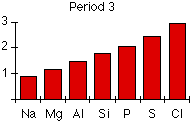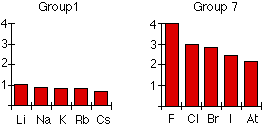Dear Pooja
Electronegativity is a measure of the tendency of an atom to attract a bonding pair of electrons. The Pauling scale is the most commonly used. Fluorine (the most electronegative element) is given a value of 4.0, and values range down to caesium and francium which are the least electronegative at 0.7.
What happens if two atoms of equal electronegativity bond together?
Consider a bond between two atoms, A and B. Each atom may be forming other bonds as well as the one shown - but these are irrelevant to the argument.

If the atoms are equally electronegative, both have the same tendency to attract the bonding pair of electrons, and so it will be found on average half way between the two atoms. To get a bond like this, A and B would usually have to be the same atom. You will find this sort of bond in, for example, H2 or Cl2 molecules.
What happens if B is slightly more electronegative than A?
B will attract the electron pair rather more than A does.

That means that the B end of the bond has more than its fair share of electron density and so becomes slightly negative. At the same time, the A end (rather short of electrons) becomes slightly positive. In the diagram, " " (read as "delta") means "slightly" - so
" (read as "delta") means "slightly" - so  + means "slightly positive".
+ means "slightly positive".
What happens if B is a lot more electronegative than A?
In this case, the electron pair is dragged right over to B's end of the bond. To all intents and purposes, A has lost control of its electron, and B has complete control over both electrons. Ions have been formed.

Patterns of electronegativity in the Periodic Table
The most electronegative element is fluorine. If you remember that fact, everything becomes easy, because electronegativity must always increase towards fluorine in the Periodic Table.
Trends in electronegativity across a period
As you go across a period the electronegativity increases. The chart shows electronegativities from sodium to chlorine - you have to ignore argon. It doesn't have an electronegativity, because it doesn't form bonds.

Trends in electronegativity down a group
As you go down a group, electronegativity decreases. (If it increases up to fluorine, it must decrease as you go down.) The chart shows the patterns of electronegativity in Groups 1 and 7.

Explaining the patterns in electronegativity
The attraction that a bonding pair of electrons feels for a particular nucleus depends on:
-
the number of protons in the nucleus;
-
the distance from the nucleus;
-
the amount of screening by inner electrons.
All the best.
AKASH GOYAL
AskiitiansExpert-IIT Delhi
Please feel free to post as many doubts on our discussion forum as you can. We are all IITians and here to help you in your IIT JEE preparation.
Win exciting gifts by answering the questions on Discussion Forum. So help discuss any query on askiitians forum and become an Elite Expert League askiitian.
Now you score 5+15 POINTS by uploading your Pic and Downloading the Askiitians Toolbar respectively : Click here to download the toolbar..














